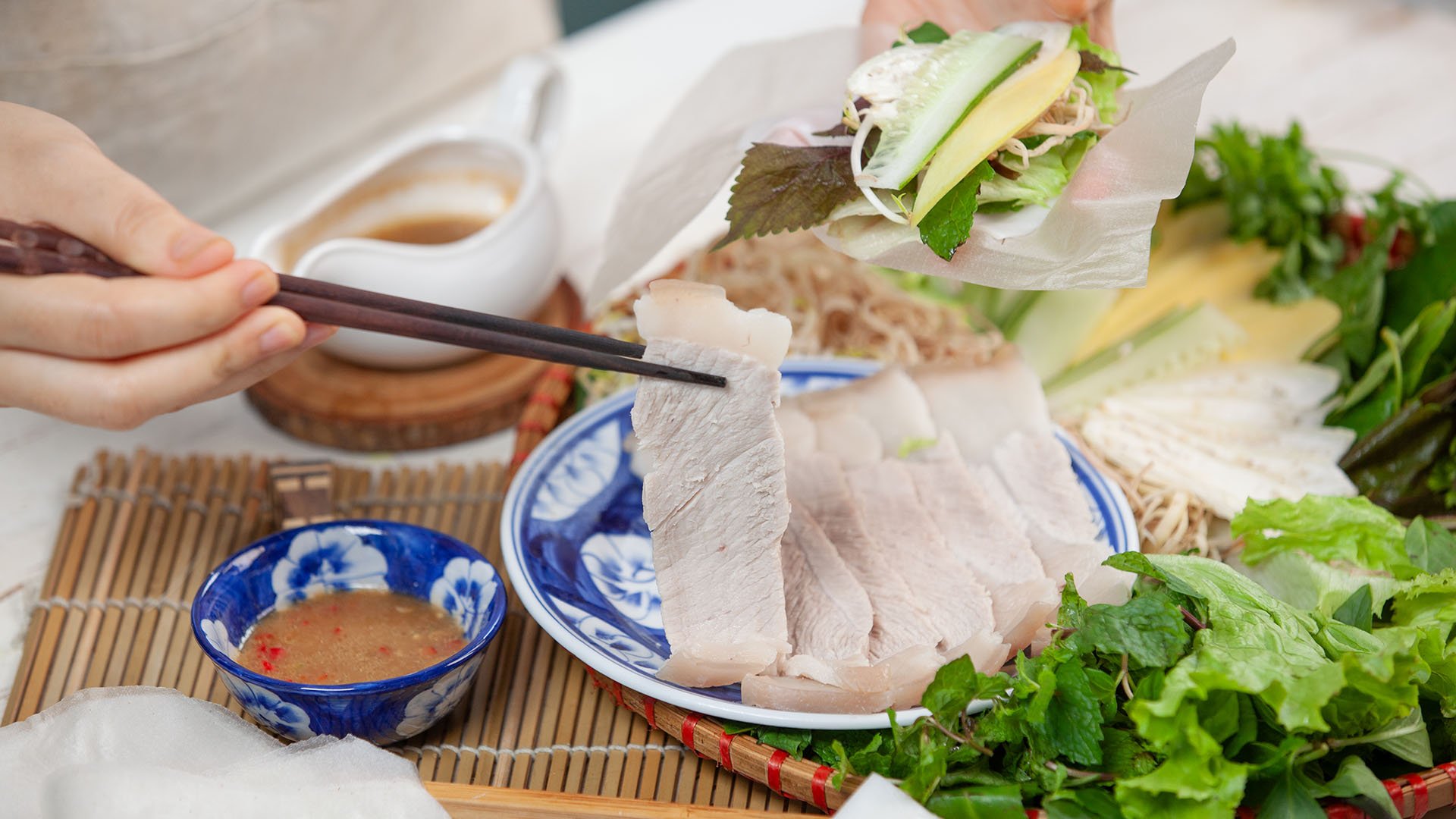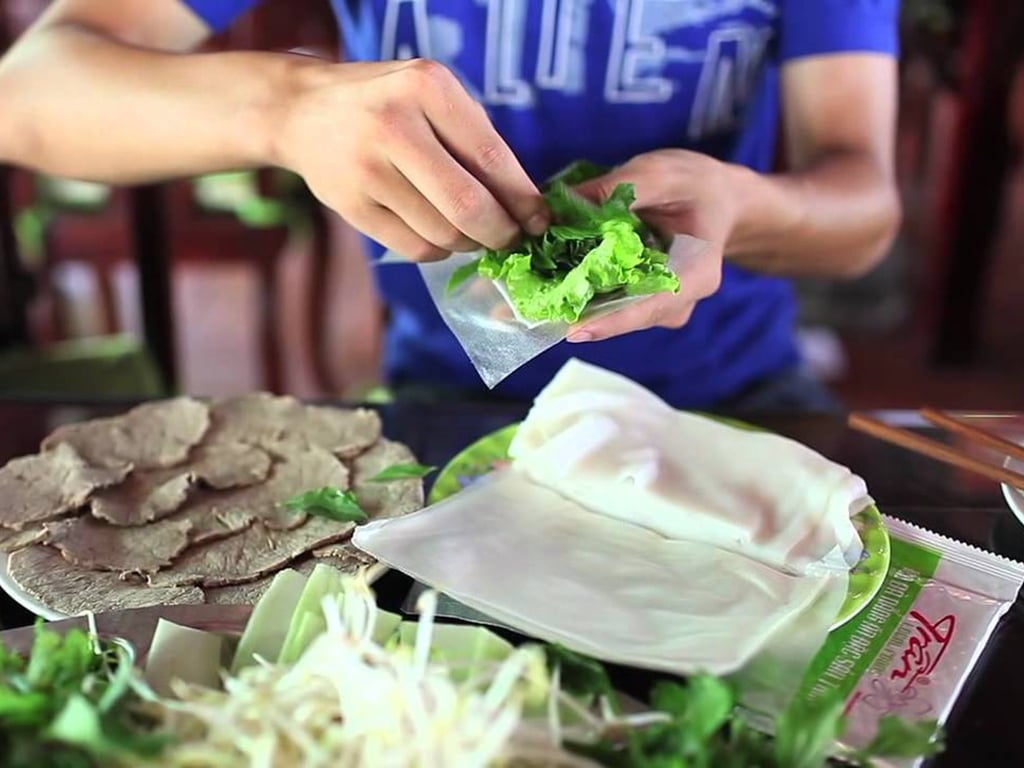Da Nang Double-skinned Pork Rolls: Discover the culinary quintessence of Central Vietnam
1. Some features of the famous Da Nang dish of rice paper rolls with pork skin
Coming to Da Nang without eating pork rolled in rice paper is considered as not having been to this land (Photo source: Collected)
The most important ingredient in the dish is boiled pork. The meat chosen is usually pork belly or rump, with a balance between fat and lean meat, helping the meat after boiling to retain its natural sweetness and softness, without being dry or pulpy. In particular, the skin must be moderately soft, the fat layer clear, not greasy, when eaten, you will feel the light fat mixed with the characteristic sweetness of fresh meat.
Different from many other rolls in other regions, Da Nang pork rolls use two types of rice paper at the same time: thin rice paper with elasticity to keep the roll firm and soft rice noodles to make the dish more attractive. When rolled, this combination creates a feeling that is both firm in the mouth and soft and easy to eat.
Indispensable in this dish are the rich accompanying raw vegetables, with more than a dozen types of vegetables such as: lettuce, basil, fish mint, perilla, herbs, bean sprouts, thinly sliced banana blossom, green banana, cucumber... Each type of vegetable brings its own nuances: astringent, spicy, sweet, cool, helping to balance the fatty taste of the meat and making the dish harmonious, not boring.
The highlight that makes the difference is Da Nang fish sauce - an indispensable dipping sauce when enjoying this specialty. Fish sauce is carefully mixed from pure anchovy fish sauce, combined with pineapple, garlic, chili and sugar to create a thick mixture, with a rich salty and sweet taste mixed with a bit of spicy, the attractive aroma typical of Central cuisine.
The interesting thing about eating Da Nang pork rolls is that the diner will roll the rolls themselves: spread the rice paper, line it with pho noodles, arrange the pork, add raw vegetables according to preference, roll it up and dip it in a bowl of shimmering fish sauce. As soon as you enjoy it, the sweetness of the meat, the freshness of the vegetables, the toughness of the rice paper and the rich, spicy flavor of the fish sauce blend together, bringing an impressive, unforgettable Da Nang culinary experience to anyone.
2. Places to enjoy rice paper rolls with pork
Tran Da Nang Cuisine - Rich in Quang Nam flavor (Photo source: Collected)
When you come to Da Nang, you will easily find Da Nang pork rolls on every street, from rustic eateries to famous restaurants. Below are the addresses that are loved and highly appreciated by many tourists:
- Quan Tran: Stands out as one of the oldest and most famous places in Da Nang specializing in serving rice paper rolls with pork. The restaurant has a wide network of branches throughout the city, famous for its tender pork, fresh vegetables and airy space, creating a pleasant feeling for diners.
- Quan Mau: This is a familiar place for locals and tourists from near and far. Quan Mau is attractive because of its rustic, rich flavor and reasonable price. In particular, the fish sauce here is mixed according to a family secret, bringing a unique and unforgettable flavor.
- Ba Huong Pork Rice Paper: Located in a bustling area of the city, Ba Huong attracts a large number of customers thanks to its spacious space, fast service and consistently high quality food. This is also a familiar destination recommended by many locals.
- Dai Loc Nho: The restaurant carries the special flavor of Dai Loc ( Quang Nam ) - considered the cradle of this dish. The pork here is often steamed, helping to retain its natural sweetness, combined with fresh vegetables to create a harmonious flavor.
Da Nang pork rolls are not just a simple dish, but also a unique culinary symbol of the coastal city. If you have the opportunity to visit Da Nang, do not forget to enjoy this famous delicacy to fully experience the delicate flavor and bring yourself an unforgettable experience.
Source: https://www.vietravel.com/vn/am-thuc-kham-pha/banh-trang-cuon-thit-heo-hai-dau-da-da-nang-v17496.aspx

































![[Photo] Gia Lai provincial leaders offer flowers at Uncle Ho's Monument with the ethnic groups of the Central Highlands](https://vphoto.vietnam.vn/thumb/1200x675/vietnam/resource/IMAGE/2025/7/9/196438801da24b3cb6158d0501984818)




































































Comment (0)